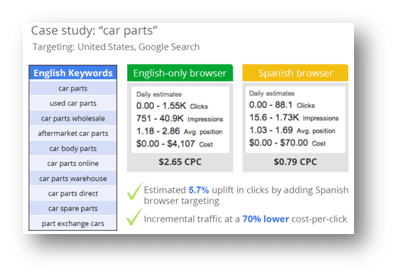Marketers in U.S. companies often underestimate the presence and buying power of Spanish speakers in local markets. According to Google, over 30% of online media consumption in the United States is conducted by searchers who use both Spanish and English interchangeably.
So, how could shifting your marketing plan to include Spanish search habits impact your brand's success? Let's take a closer look…
Supply and Demand
The English-Spanish bilingual searchers tend to be a huge area of missed opportunity for US-based advertisers. If the primary language used in their households is Spanish, their browser settings are likely to be set to Spanish, yet only 2% of US based websites support Spanish.
As marketers, you should know all about supply and demand. So, if there's demand, why shouldn't you supply? And the demand is clear: the Spanish speaking population in the US is approaching 20% (1 in 5!).
This isn't at all hypothetical. Here's a look at how this is impacting the real world:
Google recently shared a case study of searches related to "car parts". The results show a cost-per-click of $.79 for searches in a Spanish browser.
This is compared directly to a cost-per-click of $2.65 in an English-only browser. That's nearly 3.5x lower in cost! The study also concluded that providing search results in Spanish led to a 5.7% uplift in clicks!
Focusing on Multilingual SEO
So, what implications does this study have when it comes to your SEO efforts? You probably (hopefully) have an idea about your brand's SEO trends. But if you want to optimize your content for Spanish search, you need to have an idea of your Spanish keywords.
Establishing a multilingual site means you need to have a separate plan for your multilingual SEO strategy. By monitoring keywords in Spanish browsers, you can gain insights into the search habits and preferences of Spanish-speaking audiences. This helps in tailoring content to resonate with this demographic.
Optimizing for keywords that are popular in Spanish browsers can also enhance the visibility of a website in search engine results pages (SERPs) for those specific terms. This leads to better SEO performance in a target market.
How to Select Website Translation
The first thing to note when choosing a language service is that Google Translate is not translation. It’s like asking your site visitor to take a taxi when you can call them an Uber.
This is in part due to the differences between browser and server-based translation and quality of translation. It is also because Google’s quality guidelines lead to a decrease in search engine rankings for websites that utilize automated content. This includes content that has been "translated by an automated tool without prior review or curation by a human before it is published," as stated by Google. Ironically, this would include Google Translate.
Investing in your website and SEO are important, and they're worthy of a translation solution that does them justice. The best website translation solution can ensure that your content resonates with Spanish-speaking audiences and builds trust. Find a solution that will set you up for SEO success among Spanish internet browsers.
The Bottom Line
In the end, marketers in the U.S. should be aware of the growing audience of Spanish-speaking and, in times where you seek to outperform budget with higher sales, here is your return on marketing strategy for 2024.
Translating your website is the perfect first step in reaching multilingual audiences but paying attention to U.S. Hispanic search trends is the only way to help those audiences find you. Team up with MotionPoint to ensure your content is performing well on English and Spanish browsers.
Last updated on February 12, 2024
